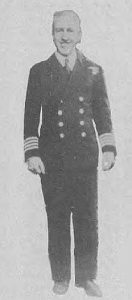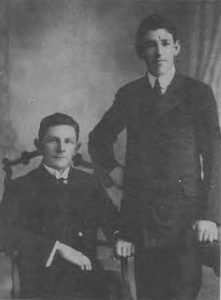- Author
- Scrivner, R.
- Subjects
- Biographies and personal histories
- Tags
-
- RAN Ships
- HMAS Yarra II, HMAS Sydney II, HMAS Sydney I, HMAS Penguin (Shore Base - Balmoral), HMAS Hobart II, HMAS Tasmania, HMAS Vampire I, HMAS Huon I, HMAS Canberra I, HMAS Brisbane I, HMAS Perth I, HMAS Hobart I, HMAS Protector I, HMAS Albatross
- Publication
- December 1974 edition of the Naval Historical Review (all rights reserved)

No member of the Royal Australian Navy who served in wartime could show as much appreciation of their captain as did the crew, officers and ratings of the three Amphion class (Improved Leander) six-inch cruisers, Sydney, Hobart and Perth.
CERTAINLY THERE WAS, in command, first class material, products of our Naval College; but with four straight rings on each sleeve, to indicate equality with each other on the bridge of whatever cruiser’s bridge enters the comparison’s field, none was of similar background. None, in fact, therefore could claim other than Royal Australian Naval College training – that is, none other than Harry Howden. Of all the ‘pusser’ bred and indoctrinated true-blue Naval Officers, strange it seems that the one of whom we write was never to experience the boy-man training, nor receive the foundation for the future world-recognised qualifications accompanying many officers of our Australian Navy, so often tested under trying but proving war conditions.
The two other Amphion class cruiser Captains referred to were the late H. M. L. Waller, DSO and Bar, RAN, and Vice- Admiral Sir John Collins, KBE, CB, RAN, the latter joining the hero’s ranks through his masterly handling of the action in the Mediterranean Sea when his ship Sydney wounded to death the Italian cruiser of equal stamina and power, Bartolomeo Colleoni, the former entering these ranks already a hero – thanks to his outstanding ability against German and Italian forces, air and sea, again in the Mediterranean theatre of war. And now we see our third member of The Hero Trio emerging, already well established as a tried member, through experience gained in a capacity seldom, if ever, found in the pages of personal exploits of RAN officers during peacetime service – on the China Squadron, as Commanding Officer, with the rank of Lieutenant-Commander, later Commander, of a Royal Navy River Gunboat. It does strike an echoing note that Captain Howden’s only wartime command should be of the second of the three sisters, in the same area of activity as those of the men mentioned, yet his most recognised hour was closer to his appointed homeland. His ship, Hobart, managed to do justice to her sister’s reputations, whilst operating out of Alexandria and into the Mediterranean Sea, and whilst as guardian of our Australian shores. Still enjoying sea duties with Perth, her Captain was to become the leader of a crew which showed more respect for him than for any other under whom they were to serve, either on this ship or another to which they may have been drafted. Such was this man’s power of command, his power of leadership, and his powerful humanitarianism that not only did he do well for his own crew, but, as we shall see, he did well for other ships’ crews. And this man’s finest hours were to come whilst under constant attack by aircraft of the Japanese forces during the period of Singapore’s fall, the East Indies over-running and the wiping-out of the major portion of the surviving Allied fleet, so hard pressed in a do-or-die stand against overwhelming Japanese Naval forces. Such heroics as were witnessed by so many respecting men will unfold during this biography.
This man Howden started off on a seafollowing career, as has been the case of thousands of British youths over the centuries.
Born in New Zealand of English/Scottish parents, evidently young Harry was keen, from an early age, to join the sea-going fraternity, being influenced by a family relation who had shipping interests. His father had previously held command of a sailing ship, experiencing the rigours of the tropics and the frozen lands, United Kingdom to India via the Capes.
Schooling in New Zealand seemed to provide little of interest either to the reader or Harry – or he spent whatever periods he could on a friend’s ship under sail, finally, at the outbreak of war in 1914, succeeding in gathering his father’s permission to sail to England.

Without qualifications of the sort needed by such staunch-hearted men to be preened for commission in His Majesty’s Navy, Harry Howden managed, we imagine through displays of determination and enthusiasm, to gain entry, in the uniform of midshipman, Royal Naval Reserve. We can only imagine his delight. And we can more readily imagine his delight when, in 1916, he was serving in the battleship Benbow, attached to the Grand Fleet, this after a period in a minesweeper.
The Australian Government of the day had sent out feelers for officers to transfer to the newly founded Royal Australian Navy, and it is here that we learn of the offering of his services, and acceptance of them, by the RAN.
So Midshipman (Probationary) Harry Leslie Howden, RAN, entered the service which was to be served so well by him, and which he found served him to equal standard. The story was passed around at the time of Midshipman Howden’s arrival in this country that the one hundred or so junior officers had transferred knowing that things would not be so good for them once the war had ended, and that Australia would offer better conditions and, at least, food and work. So they were named ‘The Hungry Hundred’.
Prior to service in Australian waters, and whilst having transferred to the RAN, Midshipman Howden saw service in two of Australia’s modern cruisers, firstly Sydney, 1918-1919, then Brisbane immediately followed, until 1920. Promotions came quickly once having gained the confirmed rank of Sub-Lieutenant in July 1917, for, in just under two years, he was confirmed Lieutenant. Although he was to wait eight years before gaining his ‘half-ring’ of Lieutenant-Commander, once gained it was only four and a half years before Commander’s rank introduced Harry Howden to the Senior Officer’s field and under circumstances unique in the history of the Royal Australian Navy.
Here it was that, whilst in command of HMS Mantis, River Gunboat of the Royal Navy’s China Station, Commander Howden’s most memorable peacetime exploits were to unfold. Also, the opportunity of command brought out this man’s independent attitude, and ability to execute inspirations not of the orthodox.




